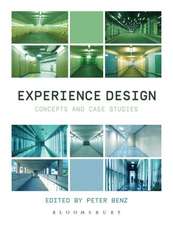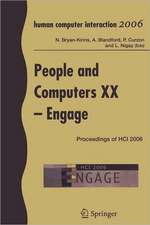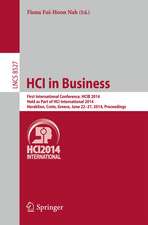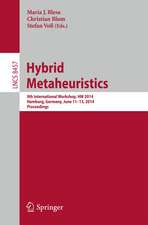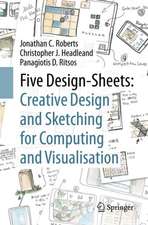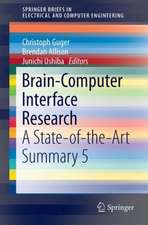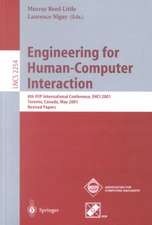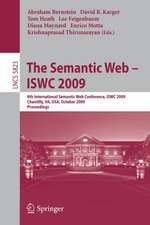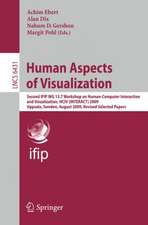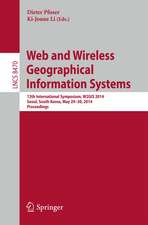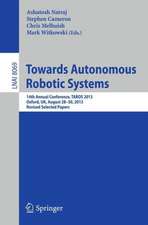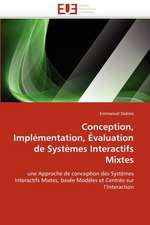The Engineering of Mixed Reality Systems: Human–Computer Interaction Series
Editat de Emmanuel Dubois, Philip Gray, Laurence Nigayen Limba Engleză Paperback – 14 mar 2012
Divided into three parts: interaction design, software design and implementation, the first section covers generic and specific mixed reality design elements and provides an overview of the design method; Part 2 addresses technical solutions for interaction techniques, development tools and a global view of the mixed reality software development process. The final section contains detailed case studies to highlight the application of mixed reality in a variety of fields including aviation, architecture, emergency management, games, and healthcare.
| Toate formatele și edițiile | Preț | Express |
|---|---|---|
| Paperback (1) | 1279.86 lei 6-8 săpt. | |
| SPRINGER LONDON – 14 mar 2012 | 1279.86 lei 6-8 săpt. | |
| Hardback (1) | 1286.29 lei 6-8 săpt. | |
| SPRINGER LONDON – 18 noi 2009 | 1286.29 lei 6-8 săpt. |
Din seria Human–Computer Interaction Series
- 20%
 Preț: 655.85 lei
Preț: 655.85 lei - 20%
 Preț: 309.27 lei
Preț: 309.27 lei - 20%
 Preț: 375.54 lei
Preț: 375.54 lei - 20%
 Preț: 644.48 lei
Preț: 644.48 lei - 20%
 Preț: 667.75 lei
Preț: 667.75 lei - 20%
 Preț: 664.44 lei
Preț: 664.44 lei - 20%
 Preț: 1164.84 lei
Preț: 1164.84 lei - 20%
 Preț: 817.55 lei
Preț: 817.55 lei - 20%
 Preț: 657.16 lei
Preț: 657.16 lei - 20%
 Preț: 645.31 lei
Preț: 645.31 lei - 20%
 Preț: 938.66 lei
Preț: 938.66 lei - 15%
 Preț: 658.05 lei
Preț: 658.05 lei - 20%
 Preț: 822.51 lei
Preț: 822.51 lei - 20%
 Preț: 654.21 lei
Preț: 654.21 lei - 20%
 Preț: 994.26 lei
Preț: 994.26 lei - 20%
 Preț: 1621.89 lei
Preț: 1621.89 lei - 20%
 Preț: 991.60 lei
Preț: 991.60 lei - 20%
 Preț: 783.46 lei
Preț: 783.46 lei - 20%
 Preț: 1175.42 lei
Preț: 1175.42 lei - 20%
 Preț: 659.97 lei
Preț: 659.97 lei - 20%
 Preț: 219.15 lei
Preț: 219.15 lei - 20%
 Preț: 334.86 lei
Preț: 334.86 lei - 20%
 Preț: 969.85 lei
Preț: 969.85 lei - 20%
 Preț: 642.19 lei
Preț: 642.19 lei - 20%
 Preț: 314.39 lei
Preț: 314.39 lei - 20%
 Preț: 661.14 lei
Preț: 661.14 lei - 20%
 Preț: 995.89 lei
Preț: 995.89 lei - 20%
 Preț: 752.59 lei
Preț: 752.59 lei - 20%
 Preț: 990.30 lei
Preț: 990.30 lei - 20%
 Preț: 990.12 lei
Preț: 990.12 lei - 20%
 Preț: 336.21 lei
Preț: 336.21 lei - 20%
 Preț: 334.71 lei
Preț: 334.71 lei - 20%
 Preț: 312.62 lei
Preț: 312.62 lei - 20%
 Preț: 994.92 lei
Preț: 994.92 lei - 20%
 Preț: 331.74 lei
Preț: 331.74 lei - 20%
 Preț: 646.80 lei
Preț: 646.80 lei - 20%
 Preț: 334.86 lei
Preț: 334.86 lei - 20%
 Preț: 994.40 lei
Preț: 994.40 lei - 20%
 Preț: 329.76 lei
Preț: 329.76 lei - 20%
 Preț: 332.24 lei
Preț: 332.24 lei - 20%
 Preț: 992.11 lei
Preț: 992.11 lei - 20%
 Preț: 650.40 lei
Preț: 650.40 lei - 20%
 Preț: 337.00 lei
Preț: 337.00 lei - 20%
 Preț: 332.39 lei
Preț: 332.39 lei - 15%
 Preț: 636.12 lei
Preț: 636.12 lei - 20%
 Preț: 336.67 lei
Preț: 336.67 lei - 20%
 Preț: 1000.70 lei
Preț: 1000.70 lei - 20%
 Preț: 645.14 lei
Preț: 645.14 lei
Preț: 1279.86 lei
Preț vechi: 1599.82 lei
-20% Nou
Puncte Express: 1920
Preț estimativ în valută:
244.93€ • 254.77$ • 202.21£
244.93€ • 254.77$ • 202.21£
Carte tipărită la comandă
Livrare economică 14-28 aprilie
Preluare comenzi: 021 569.72.76
Specificații
ISBN-13: 9781447125228
ISBN-10: 1447125223
Pagini: 464
Ilustrații: XIV, 450 p. 170 illus.
Dimensiuni: 155 x 235 x 24 mm
Greutate: 0.64 kg
Ediția:2010
Editura: SPRINGER LONDON
Colecția Springer
Seria Human–Computer Interaction Series
Locul publicării:London, United Kingdom
ISBN-10: 1447125223
Pagini: 464
Ilustrații: XIV, 450 p. 170 illus.
Dimensiuni: 155 x 235 x 24 mm
Greutate: 0.64 kg
Ediția:2010
Editura: SPRINGER LONDON
Colecția Springer
Seria Human–Computer Interaction Series
Locul publicării:London, United Kingdom
Public țintă
ResearchCuprins
Interaction Design.- An Integrating Framework for Mixed Systems.- A Holistic Approach to Design and Evaluation of Mixed Reality Systems.- Embedded Mixed Reality Environments.- The Semantic Environment: Heuristics for a Cross-Context Human–Information Interaction Model.- Tangible Interaction in Mixed Reality Systems.- Designing a Mixed Reality Intergenerational Entertainment System.- Auditory-Induced Presence in Mixed Reality Environments and Related Technology.- An Exploration of Exertion in Mixed Reality Systems via the “Table Tennis for Three” Game.- Developing Mixed Interactive Systems: A Model-Based Process for Generating and Managing Design Solutions.- Software Design and Implementation.- Designing Outdoor Mixed Reality Hardware Systems.- Multimodal Excitatory Interfaces with Automatic Content Classification.- Management of Tracking for Mixed and Augmented Reality Systems.- Authoring Immersive Mixed Reality Experiences.- Fiia: A Model-Based Approach to Engineering Collaborative Augmented Reality.- A Software Engineering Method for the Design of Mixed Reality Systems.- Applications of Mixed Reality.- Enhancing Health-Care Services with Mixed Reality Systems.- The eXperience Induction Machine: A New Paradigm for Mixed-Reality Interaction Design and Psychological Experimentation.- MyCoach: In Situ User Evaluation of a Virtual and Physical Coach for Running.- The RoboCup Mixed Reality League – A Case Study.- Mixed-Reality Prototypes to Support Early Creative Design.
Textul de pe ultima copertă
Mixed reality computer systems aim to fuse digital and physical information and features, either as an augmentation of real-world environments or as a means of providing physically-based interaction with computer-based systems. So – for example – museum displays can be augmented with added information about their history and provenance, and this information delivered to a visitor via their mobile telephone as they pass in front of the display.
An increasing number of systems are exploiting mixed reality but to date there are no systematic methods, techniques or guidelines for the development of such systems. In bringing together contributions on a broad range of mixed reality development issues this book provides a sound theoretical foundation for a disciplined approach to mixed reality engineering.
Divided into three parts, interaction design, software design and implementation, this book brings together state of the art developments in the engineering of mixed reality systems, addressing issues at these three levels. Part 1 covers generic and specific mixed reality design elements and provides an overview of the design method; Part 2 addresses technical solutions for interaction techniques, development tools and a global view of the mixed reality software development process. Finally part 3 contains detailed case studies to highlight the application of mixed reality in a variety of fields including aviation, architecture, emergency management, games, and healthcare.
Multimodal and tangible interaction designers, systems engineers working in augmented reality and ubiquitous systems, human factors researchers, and others interested in the use of mixed reality techniques in their work, will find this book a useful addition to their bookshelf.
An increasing number of systems are exploiting mixed reality but to date there are no systematic methods, techniques or guidelines for the development of such systems. In bringing together contributions on a broad range of mixed reality development issues this book provides a sound theoretical foundation for a disciplined approach to mixed reality engineering.
Divided into three parts, interaction design, software design and implementation, this book brings together state of the art developments in the engineering of mixed reality systems, addressing issues at these three levels. Part 1 covers generic and specific mixed reality design elements and provides an overview of the design method; Part 2 addresses technical solutions for interaction techniques, development tools and a global view of the mixed reality software development process. Finally part 3 contains detailed case studies to highlight the application of mixed reality in a variety of fields including aviation, architecture, emergency management, games, and healthcare.
Multimodal and tangible interaction designers, systems engineers working in augmented reality and ubiquitous systems, human factors researchers, and others interested in the use of mixed reality techniques in their work, will find this book a useful addition to their bookshelf.
Caracteristici
One of the first books to address mixed reality engineering Treats mixed reality system development as genuine engineering in which the nature of the systems demands specialised forms of engineering knowledge and principles Features a set of detailed case studies that highlight the application of mixed reality in a number of fields, including aviation, architecture, emergency management, games and healthcare



